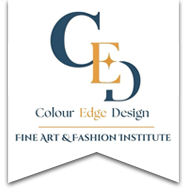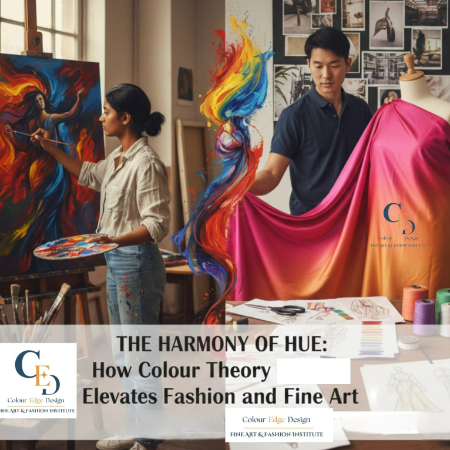
The Harmony of Hue
The Harmony of Hue: How Colour Theory Elevates Fashion and Fine Art
The world of Colour Edge Design Institute is where the painter's vibrant canvas meets the fashion designer's innovative runway. What connects these two dynamic fields, allowing for breathtaking creations in both? It's the profound and timeless principles of Colour Theory.
Colour is far more than just a visual element; it's a language. It communicates emotion, dictates perception, and forms the very essence of a compelling design or a masterful artwork. Understanding how to wield this language is the hallmark of every truly impactful artist and designer.
The Artist's Palette: Emotion, Depth, and Storytelling
For a fine artist, colour is the brushstroke that evokes feeling, creates dimension, and guides the viewer's journey through a piece.
Emotional Resonance: Imagine the serene calm of cool blues in a landscape, or the fierce passion ignited by deep reds and oranges in a portrait. Artists use colour palettes to directly influence the mood and psychological impact of their work.
Visual Dynamics: Techniques like contrast, saturation, and hue are employed to create focal points, establish depth, and achieve visual harmony. A sophisticated understanding of complementary colours, for instance, can make elements "pop" with incredible vibrancy, bringing a canvas to life.
The Designer's Fabric: Styling, Identity, and Impact
In the realm of fashion, colour is the immediate statement. It’s what captures attention, defines a collection, and expresses individuality.
Psychological Impact: Fashion designers are keenly aware of the psychological associations of different colours. A sophisticated navy can convey professionalism, while a cheerful yellow might suggest playfulness. These choices are deliberate, crafting the wearer's identity and influencing how garments are perceived.
Trendsetting: The fashion industry is deeply intertwined with colour trends, from seasonal palettes to "Colour of the Year" announcements. Our students at Colour Edge don't just follow trends; they learn the underlying principles of colour psychology and cultural significance that create these trends, empowering them to become visionary leaders in design.
The Colour Edge Advantage: Bridging Disciplines
At Colour Edge Design Institute, we believe that true mastery comes from a holistic understanding. We dismantle the traditional boundaries between fine art and fashion, teaching you how the foundational artistic principles of colour theory directly inform and elevate cutting-edge fashion design. This integrated approach equips our students with a unique and powerful skill set, enabling them to create designs that are not only aesthetically stunning but also rich with artistic depth and meaning.
Are you ready to dive into the spectrum of creativity? Explore our comprehensive programs in Fine Art and Fashion Design and discover how a command of colour can transform your artistic and design journey!.
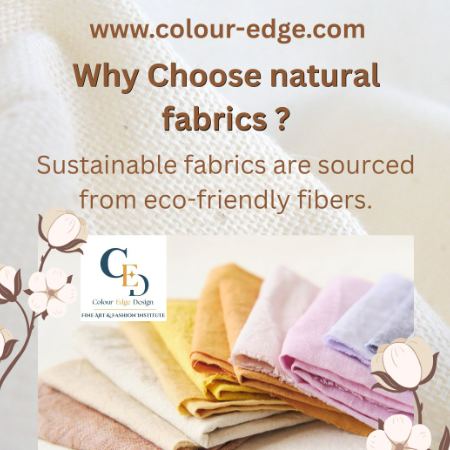
Why Choose Natural Fabric
Natural fabric is woven or knitted from fibres that occur in our natural world. All three sectors of nature; animal, vegetable and mineral produce fibres that can be used in fabric production.
Vegetable, or more commonly classed cellulose-based fibres, include cotton, flax, jute, hemp and bamboo. Each fibre type is derived from a specific part of the plant such seed hair, stem, leaf, husk etc. and consist mainly of cellulose substance.
Animal fibres include wool and silk and consist exclusively of proteins. While wool fabric is most commonly produced from the fleece of sheep, it also includes fleece from alpacas. The hairs or fibres of other animals are also constructed into fabric including rabbit fur, angora fabric and mohair.
Silk is the other notable fibre from an animal, but unlike other animal fibres, it is not made from the hair or fur covering the animal. It is the continuous thread of the spun cocoon of moth larvae. An extensive process is required to produce one silk fibre and in turn, produce silk fabric maintaining its exclusive divine nature.
Mineral fibres are less widely used in production for fashion or interior fabrics but can still be used in an industrial application. Fine drawn threads of metallic fibres can be used on regular textile machinery and are often spun or woven in combination with other fibres to make a length of fabric for industrial use.
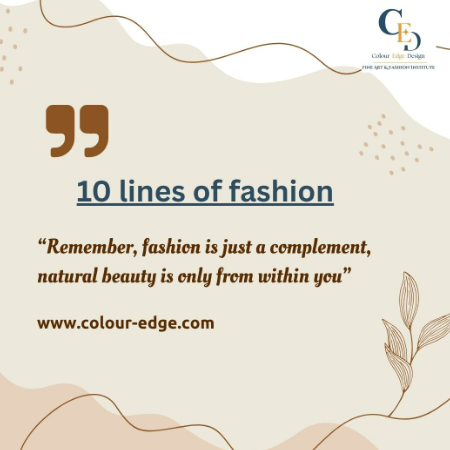
10 Lines Of Fashion
10 Lines of Fashion
1· Fashion is more than clothing; it is a powerful form of self-expression that reflects our personality, mood, culture, and creativity without saying a word.
2· Style evolves with time but is rooted in individuality. True fashion isn't about copying trends — it's about adapting them to your own identity.
3· Every design tells a story — from the choice of fabric to the cut and silhouette, fashion narrates culture, history, and emotion through stitches and seams.
4· Fashion is a global language that unites people across borders while celebrating diversity, tradition, and innovation.
5· The fashion industry blends art and commerce, transforming creativity into wearable reality through design, production, and presentation.
6· Sustainability in fashion is the future, encouraging mindful choices about fabrics, processes, and ethical values behind what we wear.
7· Fashion empowers confidence. The right outfit can change how you walk, how you feel, and how the world perceives you.
8· Designers are storytellers and visionaries, using threads instead of words to shape the future of style.
9· Fashion education shapes the trendsetters of tomorrow, teaching not just aesthetics but also technology, forecasting, and responsible design.
10· In fashion, imagination has no limits — it’s a field where creativity, craftsmanship, and bold vision come together to shape identities and inspire change.

FASHION DESIGNING COURSES AFTER 10TH
Fashion Designing Courses After 10th: Your Gateway to a Stylish Career
If you have a keen eye for style, a creative mind, and a passion for clothing, pursuing a career in fashion designing might be the perfect choice for you. With the fashion industry evolving every day, there's never been a better time to dive into it, and the best part is that you can start your journey even after completing 10th grade.
In this blog post, we’ll explore the various fashion designing courses available after 10th grade, the skills they help develop, and the exciting career opportunities they open up.
Why Choose Fashion Designing?
Fashion designing is one of the most dynamic, creative, and rewarding careers. With the global fashion industry booming, skilled designers are in high demand. Whether you're drawn to designing clothes, accessories, or textiles, a career in fashion designing allows you to express your creativity and make a significant impact in the world of style.
Not only is it a creative field, but it also offers lucrative career opportunities in various sectors like retail, media, film, and even the growing field of sustainable fashion.
Popular Fashion Designing Courses After 10th
Certificate Courses in Fashion Designing
Duration: 6 months to 1 year
Eligibility: 10th pass
Course Content: These short-term courses focus on building the basic skills required for fashion design. You'll learn the fundamentals like sketching, color theory, fabric knowledge, pattern making, and garment construction.
Career Opportunities: Junior designer, pattern maker, fashion stylist, or assistant designer.
Diploma in Fashion Designing
Duration: 1 to 2 years
Eligibility: 10th pass (in some cases, 12th pass is required)
Course Content: A more comprehensive approach to fashion, this course includes topics like design theory, pattern making, garment production, textile science, fashion merchandising, and marketing.
Career Opportunities: Fashion designer, fashion consultant, textile designer, garment technologist.
Certificate in Fashion Technology
Duration: 6 months to 1 year
Eligibility: 10th pass
Course Content: This course focuses on the technical side of fashion designing. You’ll learn garment construction, pattern making, fabric technology, and CAD (Computer-Aided Design) software used in the fashion industry.
Career Opportunities: Fashion technologist, textile designer, pattern maker, garment constructor.
Key Skills You’ll Develop in Fashion Designing Courses:
Creative Skills: Learn to sketch, illustrate, and design garments that are both visually appealing and functional.
Technical Skills: Understand garment construction, fabric types, and sewing techniques.
Fashion Knowledge: Get a strong grasp of fashion history, trends, and forecasting.
Business Acumen: Gain knowledge in fashion marketing, retailing, and merchandising, which are key to running a fashion brand.
Computer Skills: Master design software like Adobe Illustrator, Photoshop, and CAD for digital design and visualization.
Career Options After Completing Fashion Designing Courses:
Once you complete your course in fashion design, a world of career options opens up. Here are some exciting roles you can pursue:
Fashion Designer: Design clothing and accessories for individuals or brands. You can choose to work in various sectors, including ready-to-wear, haute couture, or costume design for films and theater.
Textile Designer: Specialize in designing fabric patterns and textures for clothing and home furnishings.
Fashion Stylist: Work on styling photoshoots, fashion shows, and individuals, helping them put together the perfect outfits.
Fashion Buyer: Work for fashion retailers, selecting clothing, footwear, and accessories that will appeal to customers.
Fashion Merchandiser: Oversee product development, manage stock, and work on the marketing strategy for fashion items.
Entrepreneur: If you're entrepreneurial, you could start your own fashion brand, boutique, or e-commerce store.
Conclusion
Choosing a fashion designing course after 10th is the first step toward entering one of the most exciting and ever-evolving industries in the world. Whether you're interested in designing clothes, styling, or managing fashion brands, there's a pathway for you to explore your passion and make a successful career out of it.
If you’re still in school, start exploring different courses, attend workshops, or even try your hand at sketching designs and creating DIY fashion projects. This will not only give you a head start but will also help you build the confidence needed to pursue your dreams in the fashion world.
So, what are you waiting for? Get creative, and take your first step towards a glamorous career in fashion design!
FAQs About Fashion Designing Courses After 10th
Can I pursue fashion designing after the 10th?
Yes! Many colleges offer short-term certificate and diploma courses in fashion design for students who have completed their 10th grade.
What is the eligibility for pursuing a fashion designing course?
Generally, you need to have passed your 10th grade for short-term courses and 12th grade for bachelor’s degree programs.
How much does a fashion designing course cost?
The cost of fashion designing courses varies widely depending on the course duration and the institute.
What are the job prospects after completing a fashion designing course?
Fashion designing graduates can work in various sectors such as garment production, textile industry, fashion journalism, styling, retail, and even start their own fashion brands.
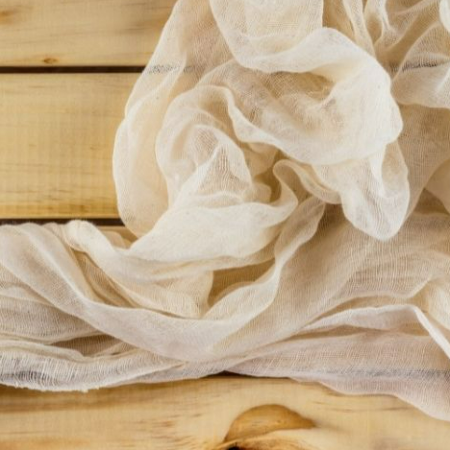
USES OF MUSLIN FABRIC
Muslin fabric
Muslin fabric is a lightweight, plain-woven cotton fabric that is widely used in fashion design, especially in draping and creating garment prototypes.
🔍 Overview of Muslin Fabric
|
Feature |
Description |
|
Material |
100% cotton (traditionally) |
|
Weave |
Plain weave |
|
Weight |
Ranges from very light to medium |
|
Colour |
Typically off-white or unbleached; also available in bleached white |
|
Texture |
Soft, breathable, slightly rough in raw form |
🧵 Uses of Muslin in Fashion Design
Muslin is used to shape and test garment designs on a dress form before finalizing a pattern.
It’s easy to pin, cut, and mark, making it ideal for experimenting with silhouettes and construction.
Creating Toile or Mock-ups:
A toile (also called a muslin) is a test version of a garment made using muslin.
Designers use it to check the fit, adjust design details, and perfect proportions before cutting expensive fabrics.
Pattern Development:
Muslin prototypes are often used to transfer shapes and lines to paper patterns.
Practice Material:
Perfect for sewing students and designers to practice garment construction techniques.
✅ Advantages
Inexpensive
Readily available
Easy to sew and manipulate
Accepts chalk markings well
Available in different weights (sheer to firm)
❗ Tip for Use
Choose the muslin weight that closely matches your final garment fabric. For example:
For light, flowing silk: use fine muslin.
For structured garments: use heavier muslin.

ELEMENTS OF FASHION DESIGN
Elements of Fashion Design:
Fashion design is a captivating blend of creativity, craftsmanship, and understanding of various elements that come together to create stunning garments. Whether you're an aspiring designer or a fashion enthusiast, understanding the fundamental elements of fashion design is essential. Here's a comprehensive overview:
Line
The line is the foundation of all design. It guides the eye and defines the shape of the garment. Lines can be straight, curved, vertical, horizontal, or diagonal, each creating a different visual effect. For example, vertical lines elongate the figure, while horizontal lines add width.
Shape and Silhouette
Shape refers to the overall form of the garment, while the silhouette is its outline or profile. The silhouette can be fitted, A-line, flared, boxy, or voluminous, influencing the mood and style of the design.
Colour
Colour sets the tone and mood of a fashion piece. It evokes emotions and communicates messages. Designers choose color palettes carefully to create harmony, contrast, or emphasis within their collections.
Texture
Texture pertains to the surface quality of the fabric or material, influencing the tactile and visual appeal. Smooth, rough, shiny, matte, soft, or stiff textures add depth and interest.
Pattern
Patterns include prints, weaves, and embellishments that add visual interest. Stripes, florals, polka dots, and plaid are common examples. Patterns can be used to make bold statements or subtle accents.
Balance and Proportion
These elements ensure the garment is visually pleasing. Balance can be symmetrical or asymmetrical, while proportion relates to the size relationships between different parts of the design.
Emphasis
Emphasis draws attention to a particular area of the garment, often through color, detail, or design features like ruffles, embroidery, or embellishments.
Rhythm
Rhythm creates a sense of movement within the design, guiding the viewer's eye across the garment in a deliberate way.
Details and Embellishments
Small design elements such as buttons, zippers, embroidery, beads, or lace add personality and uniqueness to the garment.
Functionality
While aesthetics are vital, practicality and comfort are also key elements, ensuring the garment serves its intended purpose effectively.
Conclusion
Mastering these elements allows fashion designers to craft cohesive, innovative, and aesthetically pleasing garments. Whether working on haute couture or ready-to-wear collections, understanding the interplay of these elements is essential for creating compelling fashion designs that resonate with audiences.

Fashion Designing Courses After 12th Grade
Top Fashion Designing Courses to Pursue After 12th Grade
Are you passionate about creativity, trends, and apparel? Dreaming of making it big in the fashion industry? Choosing the right fashion designing course after 12th can set you on a path to a fulfilling career. Here's a comprehensive guide to popular courses www.colour-edge.com and how they can help you turn your fashion dreams into reality.
Why Pursue Fashion Designing Courses?
Creative Expression: Bring your unique ideas to life through design.
Career Opportunities: Work as a fashion designer, stylist, merchandiser, or entrepreneur.
Industry Growth: The fashion industry is expanding globally, offering diverse opportunities.
Popular Fashion Designing Courses After 12th
Bachelor of Design (B.sc) in Fashion Design ( https://colour-edge.com/fashion-designing/)
Duration: 3 years
Description: A comprehensive undergraduate program focusing on apparel design, textile designing, and fashion illustration.
https://colour-edge.com/fashion-designing/
Diploma in Fashion Designing
Duration: 1-2 years
Description: A shorter course ideal for quick entry into the industry, covering basics of fashion, sketching, and garment construction.
Certificate Courses in Fashion Design
Duration: Few months to 1 year
Suitable for beginners looking to gain foundational knowledge.
Specialized Courses
Fashion styling, accessory designing, textile designing, and fashion photography.
Eligibility Criteria
Completed 12th grade in any stream (Science, Commerce, Arts)
Good creative skills and a keen interest in fashion are essential
How to Choose the Right Course?
Assess Your Interests: Do you prefer designing, styling, or textile work?
Research Institutes: Look for reputed colleges with experienced faculty and industry connections.
Course Content & Opportunities: Ensure the curriculum includes practical training, internships, and industry exposure.
Career Opportunities After Fashion Designing Courses
Fashion Designer
Fashion Stylist
Textile Designer
Fashion Buyer or Merchandiser
Costume Designer
Fashion Blogger/Influencer
Entrepreneur in Fashion Business
Final Tips
Build a strong portfolio showcasing your designs.
Stay updated with current fashion trends.
Intern with reputed fashion houses for hands-on experience.
Continue learning through workshops and industry events.
Embark on your fashion journey today! With the right course and passionwith Colour Edge Design. you can turn your creative ideas into a thriving career in the fashion industry.
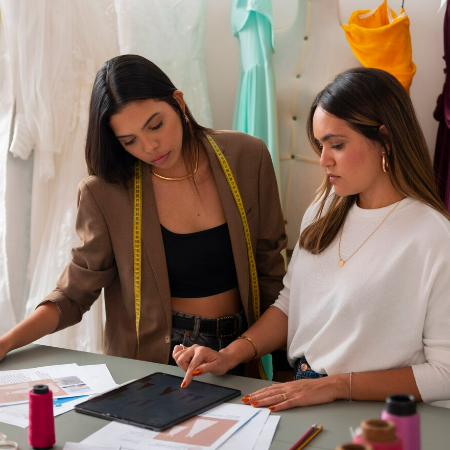
Facts About Fabric Fashion Designing
Fabric and fashion design is a multifaceted field that blends creativity, technology, and art. It involves not just creating visually appealing clothing but also understanding materials, construction techniques, cultural influences, and sustainability. Here are some interesting facts about fabric and fashion designing:
1. Types of Fabrics
Fabrics come in a wide variety of types, each with unique textures, drapes, and uses. They are generally categorized into natural fabrics (like cotton, silk, wool, and linen) and synthetic fabrics (such as polyester, nylon, rayon, and spandex). Designers choose fabrics based on the desired structure, comfort, durability, and visual effect of a garment. Some fabrics, like organza and tulle, are used for volume and drama, while others, like jersey or chiffon, offer fluidity and softness.
2. Fashion Design Involves Technical Skills
While creativity is key, fashion designing also requires technical know-how. Designers must understand pattern making, garment construction, draping, and fabric behavior. Mastery over sewing techniques and knowledge of fabric stretch, shrinkage, and flow are essential to bring a design from sketch to reality.
3. Color and Texture Matter
Fabric choice directly influences how color appears in a design. For example, silk reflects light, giving a shimmery appearance, while cotton absorbs dyes more deeply for a matte finish. Texture can add depth, contrast, or harmony to a design and significantly affects how a garment is perceived visually and tactilely.
4. The Role of Technology
Modern fashion design incorporates technology and innovation, such as digital textile printing, 3D modeling, laser cutting, and even smart fabrics that can change color or respond to temperature. Computer-Aided Design (CAD) software allows designers to create, modify, and visualize garments before producing physical samples.
5. Sustainability Is Reshaping Fashion
With growing awareness about environmental impact, sustainable fabric choices like organic cotton, bamboo, Tencel, and recycled polyester are becoming popular. Eco-friendly fashion also emphasizes reducing fabric waste through zero-waste patterns and upcycling old garments.
6. Fashion Reflects Culture and History
Fabrics often tell cultural stories. For example, batik from Indonesia, ikat from India, kente from Ghana, and tweed from Scotland each carry historical and cultural significance. Designers often draw inspiration from traditional textile arts to create modern fashion with roots in heritage.
7. Fashion Trends Are Cyclical
Fabric trends in fashion tend to be cyclical, with styles and materials from past decades frequently making a comeback. Velvet, corduroy, and denim are examples of fabrics that repeatedly find favor in new, reimagined ways.
8. Haute Couture vs. Ready-to-Wear
In high-end fashion, haute couture garments are made from luxurious fabrics and crafted by hand, often requiring hundreds of hours of labor. In contrast, ready-to-wear (prêt-à-porter) collections use more accessible materials and are mass-produced, balancing style with practicality.
